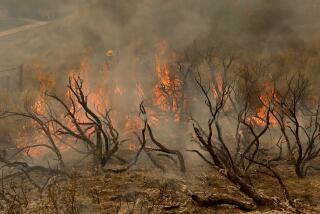Thousands relive a disaster
SAN DIEGO -- As this county burned, firefighters confronted a familiar reality: too few resources and not enough personnel to effectively make a stand.
San Diego officials say fire conditions Monday would have overwhelmed even a larger, better equipped firefighting force. They point to progress made in the four years since the devastating Cedar and Paradise fires, including a better communications system, more air support and an automated evacuation call system.
But little else has changed. Just one new city fire station has been built since 2003, and many of the area’s chronically underfunded fire departments still fall short of national standards.
Once again, firefighters here found themselves outrun by fast-moving fires that hopscotched the county. And the logistical challenge of moving at least 233,000 households out of harm’s way proved daunting.
“We’re stretched about as thin as we could possibly be,” said San Diego Fire Chief Tracy Jarman.
With little chance to stem the wind-driven fires burning through rural and suburban neighborhoods, officials, still stung by the deaths of 17 people in the 2003 fires, ordered mass evacuations. Though it was orderly, the evacuees found clogged roads, overbooked hotels and ill-equipped public shelters.
“They tell us to get the hell out of here, and you try and you can’t get anywhere,” said Warren O’Meara, 56, who stayed in his Scripps Ranch home during the Cedar fire but heeded evacuation orders Monday.
He stayed in touch with his wife by cellphone, worried that his family was moving too slowly out of the fire’s path.
“What’s going to happen, God forbid, if the fire does come and we’ve got thousands of people trapped in their cars?” he said. “It’s good that we get out, but they have to have a plan. This is crazy. There is no plan.”
A county emergency services plan completed in April optimistically called for 70,000 people to be sheltered at 670 locations. But by the end of the day Monday, the Red Cross had opened five shelters. Local governments and military authorities provided another 10.
By late afternoon, only 1,500 cots were available at the Red Cross shelters. Officials at the city of San Diego’s shelter at Qualcomm Stadium said they had some cots on hand, far short of what they needed to aid more than 500 elderly and infirm evacuees transported there -- much less the 4,500 others who had converged at the stadium by Monday evening. At Del Mar racetrack, officials had taken in 2,000 people and 2,500 large animals.
“When we started this morning we had five mattresses,” said Kina Paegert, public information officer for Del Mar Fairgrounds and Racetrack. “We were prepared for animals. We weren’t prepared for this.”
By nightfall, they’d scrounged fewer than 100 mattresses, forcing many elderly and ill to lie on the floor. Some frail patients from the nearby Via Rancho Bernardo skilled nursing home came by ambulance, only to be squeezed onto thin mattresses or laid on the bare floor. Nearly all of them bore bits of white masking tape on their foreheads, marked with their names and sometimes their conditions scrawled in black magic marker. One read “Depression.” Another, “Diabetes.”
Tim Fennell, Del Mar’s chief executive, said racetrack officials were doing their best to round up more beds for the 2,000 people planning to spend the night.
“I think these people will sleep here,” Fennell said. “What they are going to sleep on is another question.”
Elsewhere in the county, thousands more residents stood ready to flee if conditions worsened.
Jeff Bowman, who quit his job as San Diego’s fire chief earlier this year amid concerns about chronic underfunding of his department, was one of them. He packed up both his car and his wife’s and waited for word to evacuate his home near Escondido.
The fires, he said, were among the worst he had seen, driven by wind gusts of 50 mph. He watched on television as firefighters moved county residents out of the path of the blazes.
“That’s all they can do. The flame sparks are too big and the winds are too strong, there’s absolutely no way to get in front of the fire,” Bowman said. “I don’t care how many firefighters they have, they couldn’t stop what’s happening today.”
At the same time, he said it was disheartening to know that four years after some of the costliest fires in state history tore through the area, little had been done to better the odds of fighting fires there.
Bowman had told San Diego city officials it would cost at least $100 million to add needed new stations and equipment and $40 million a year more to increase staff. That investment, he said, is what it would take to bring San Diego into compliance with national standards. Those guidelines call for a city of San Diego’s size to have at least 22 more stations than the current 46, and 1,300 firefighters, up from the 980 now on staff.
But his appeal had no effect. Four months after the Cedar fire, a ballot proposal to boost hotel-motel taxes to pay for better fire protection failed to win voter approval. The City Council, mindful of the anti-tax mood of residents, has opted not to try again.
San Diego was recently denied full accreditation by the Commission on Fire Accreditation International, now called the Center for Public Safety Excellence, because many of its stations fail to meet the five-minute standard for arriving at major fires or calls for paramedic service.
“This whole county is fire protection poor,” Bowman said, noting that the city has added only one fire station in the four years since more than 5,000 homes and businesses were destroyed in the Cedar fire. And that temporary station near Qualcomm Stadium is in an area where at least two permanent stations have been recommended by fire officials for the last 20 years.
“Bottom line,” Bowman said, “is staffing has not improved.”
San Diego City Council president Scott Peters said it wouldn’t make sense for the city to plan staffing levels based on worst-case disasters. You don’t plan the size of a church, he said, based on the crowd at Easter. And, he said, firefighters are better prepared now than in 2003.
“The scene at the Cedar fire was appalling, right down to not having enough batteries for walkie-talkies,” he said.
This time, San Diego Fire Department spokesman Maurice Luque said, a new communications system allowed frontline firefighters to talk to other agencies, something they couldn’t do four years ago. “We’ve learned a lot,” he said.
Whatever lessons were learned, one scenario seemed eerily familiar. Just as the rush to fight the Cedar fire had drained the rest of the city of protection, so the rush to battle the Witch blaze again left the rest of the city vulnerable.
At one time on Monday, resources were spread so thin fighting the wildfires, said Assistant Fire Chief Javier Manier, “we had only one engine for the rest of the city.”
Joe Rubin, Tony Perry, Sonia Nazario, Alex Pham and Alan Zarembo contributed to this report.
More to Read
Sign up for Essential California
The most important California stories and recommendations in your inbox every morning.
You may occasionally receive promotional content from the Los Angeles Times.












